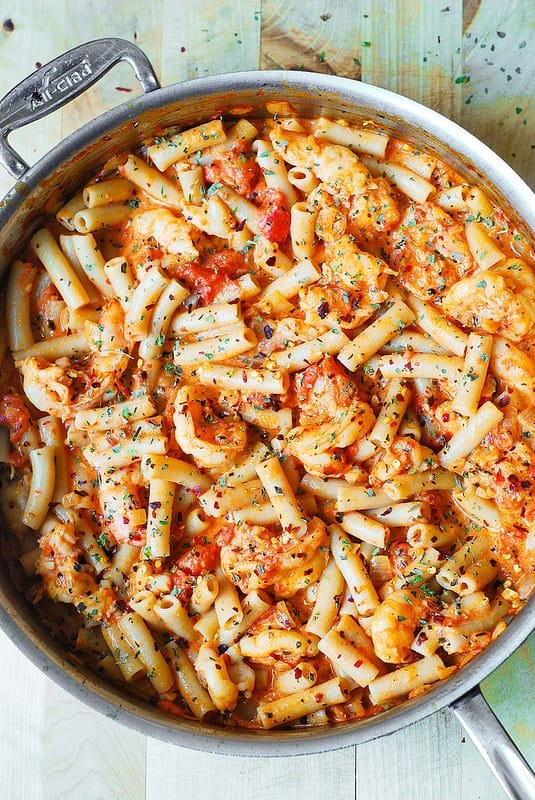Spicy Shrimp Pasta with Tomato Cream

There is a certain appeal to quick, flavorful pasta dishes that require minimal fuss yet deliver a strong impact on the dinner table. One particularly enticing option combines succulent shrimp, a tangy tomato cream base, and a flicker of heat from chili flakes or fresh peppers. Even on busier weeknights, this layered set of flavors can come together in under half an hour, resulting in a meal that feels both hearty and a touch sophisticated. The crucial point is to emphasize harmony: a note of sweetness in the sauce, a gentle kick of spice in each bite, and a savory backbone provided by plump shrimp.
Shrimp stands out as a prime protein choice for time-strapped cooks. According to the U.S. Department of Agriculture, shrimp offers a lean dose of protein alongside key minerals like selenium. It cooks in mere minutes, developing a pink hue and tender bite when handled properly. Whether you pick fresh shrimp from a local market or rely on a bag of frozen prawns, the key is ensuring they thaw thoroughly (if frozen) and that any shells or veins are removed. A brief pat dry with paper towels can help them sear efficiently, preventing watery liquids from pooling in the pan.
Many recipes begin by blooming aromatics. A small amount of olive oil or butter in a hot pan, followed by minced garlic and a sprinkle of chili flakes, can release enticing fragrances. The level of spice hinges on personal preference: some cooks dash in a teaspoon of crushed red pepper for a sharper punch, while others settle for a milder approach. In either case, timing is vital. Garlic browns quickly, so stirring gently prevents scorching. Once the garlic turns fragrant—usually within a minute—it’s time to add the shrimp in a single layer.
Allowing the shrimp to develop a slight sear on both sides intensifies flavor and texture. This step can create a light crust, locking in moisture so the shrimp remains succulent in the forthcoming sauce. After a couple of minutes per side, the shrimp may be set aside temporarily, avoiding overcooking. The pan, still warm, provides a base for the tomato-infused cream sauce, which will envelope the shrimp later. Some prefer to add a splash of white wine or stock to deglaze any browned bits, drawing deeper undertones into the sauce.
The sauce unrolls its layers with a small addition of diced tomatoes or crushed tomatoes—enough to supply tang and color, but not so much that it overtakes the dish. From there, stirring in half-and-half or light cream balances out the acidity, forming a velvety consistency. A few sprigs of fresh basil or a pinch of dried oregano can soften the tang while contributing earthy notes. Some cooks even swirl in a touch of grated Parmesan at this stage, boosting the sauce’s richness and subtle umami. The idea is not to drown the pasta in cream, but to yield a cohesive blend that complements the shrimp’s brine and the underlying spice.
Pasta selection can further shape the meal. Long strands like linguine or spaghetti wrap gracefully around each piece of shrimp, while shorter shapes such as penne or fusilli collect pockets of sauce in their ridges. Cooking the pasta al dente—in salted water—ensures it maintains a pleasant chew even after briefly simmering in the finished sauce. Once drained, it can be added directly to the pan or placed in a serving dish where the sauce and shrimp are ladled on top. Either approach preserves warmth and helps the pasta absorb the sauce’s final notes.
Reintroducing the shrimp near the end brings the dish together. If any juices have pooled under the cooked shrimp, they can go in as well, reinforcing the overall flavor. A few moments of gentle simmering unite the pasta, sauce, and shrimp in a single pan, letting the spice circulate through every strand. Throughout this final minute or two, a taste test can guide last-second adjustments—more salt to enhance clarity, a grind of black pepper for depth, or a dash of chili flake if additional heat is wanted.
When plating, garnish can elevate appearance and taste. Fresh basil leaves or a touch of chopped parsley lend color and a certain herbal brightness that counters the sauce’s richness. An optional dusting of Parmesan cheese melts lightly upon contact, accentuating the creamy tomato essence. Some diners appreciate an extra drizzle of high-quality olive oil, especially over pasta dishes where robust flavors combine. The meal’s final effect is a balanced interplay of sweet tomatoes, spicy warmth, and soft shrimp, bound together in a sauce that clings to each morsel of pasta.
For many, this recipe falls under the umbrella of “weeknight special,” flexible enough for everyday cooking yet easily adapted for more elaborate entertaining. Substitutions—like using chicken instead of shrimp or adjusting the chili level—illustrate how malleable the framework is. But the essence remains rooted in a straightforward principle: highlighting key fresh ingredients, seasoning them thoughtfully, and uniting them in a single pot with minimal fuss. By the time each plate hits the table, there’s an unmistakable sense of satisfaction in knowing that a quick, bold meal can arise from pantry staples and a bit of creativity.
